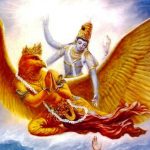Garuda, or Garutman, as he was known in the Vedas, was appropriated in the devotional myths of the epic and Puranic periods as the servant vehicle of Lord Vishnu. The name Garuda has as its verbal root gri (to speak). In the Vedas Garuda is the metaphor for, or, for those who would literalize these concepts, the personification of, the magical words (mantra, rik). Thus it was on Garuda’s wings that one was transported to the realm of the gods (either the mantras or “the self,” which could be understood metaphorically as either the subtle realm where the mantras had their origin or as the Self, the deepest level of consciousness and of all reality). Before Garuda was completely literalized, Vishnu rode as his vehicle (vahana) on rhythms (rik), sounds (saman), and sacrifices (yajna), the components of Vedic ritual. Garuda’s role in another mythology, the cult of Surya (sun) as the Supreme, has left few traces except its late reconstruction at the great sun temple at Konaraka.
In Puranic mythology Garuda myths abound. The vehicle of Lord Vishnu had a great birth, worthy deeds, and supreme powers. His birth stories all attested to his importance, even though they were otherwise inconsistent. One version had him born on the basis of the great austerities (tapas) of his mother, Vinata. Both she and her rival, Kadru, were given boons by their husband Kasyapa-Prajapati. Kadru chose to have a thousands sons, the nagas (snakes), and they hatched first. Vinata chose only to have two sons, but ones greater than Kadru’s. In her impatience Vinata opened one of her two eggs and brought Aruna (the red one) half-hatched into the world. Aruna cursed his mother with servitude and left to become Surya’s charioteer. (For more, see the entry on Aruna. Note here another connection between Garuda and Surya. Garuda was born from the second egg and then served the god who appropriated Surya’s powers and attributes as a solar deity, Vishnu.)
Kadru (the vessel for soma) and Vinata (personification of bowing to knowledge) are literalized as rival wives. These personifications sanskritize the myth and turn Vedic concepts into goddesses. Vinata became the humiliated servant of Kadru, helping tend her sons.
Other versions told of Garuda as the product of Kasiyapa’s practices (yajnas) combined with the magical practices (yagasakti) of the Balakhilyas, a class of tiny divine sages, each the size of a thumb. They gave their accumulated merit to Kasyapa to have a son who would defeat Indra. Garuda was the result: so brilliant that he hurt the gods’ eyes and worshipped by them mistakenly as Agni. Garuda was a shape-changer, going wherever he pleased, stopping the rotation of the worlds with the wind from his wings, with eyes of fire, and an enemy of snakes.
At this point the mythic versions merged. Garuda had to free his mother from the tyranny of Kadru and her naga children. A bargain was made for an exchange of the pot of divine nectar (amrita) for his mother’s freedom. Garuda flew to heaven, fought the devas (gods), blinding them with a sandstorm from his great wings and taking the pot of amrita. He so impressed Vishnu that Vishnu granted him a boon of immortality. Garuda pledged that he would serve Vishnu and become his vehicle. Indra and Garuda fought again, and a respect arose between the two heroes after their combat. Garuda told Indra why he had stolen the pot of amrita, not for himself but to save his mother. He told Indra to follow and steal it back from the nagas. Then he flew to their kingdom, exchanged the pot for his mother, and flew away. Garuda had told them that they must be pure before drinking the nectar of immortality. So, while the nagas took a bath, Indra stole the amrita and took it back to the devas. The nagas licked the darbha grass where the pot had been placed, and the sharp grass split their tongues.
More Garuda myths abound, both about the great eagle alone and as Vishnu’s servant vehicle. He made an interesting mythological appearance in the royal symbolism of Buddhist Thailand, where, as the sun eagle, he represented royal power and divine approval.

